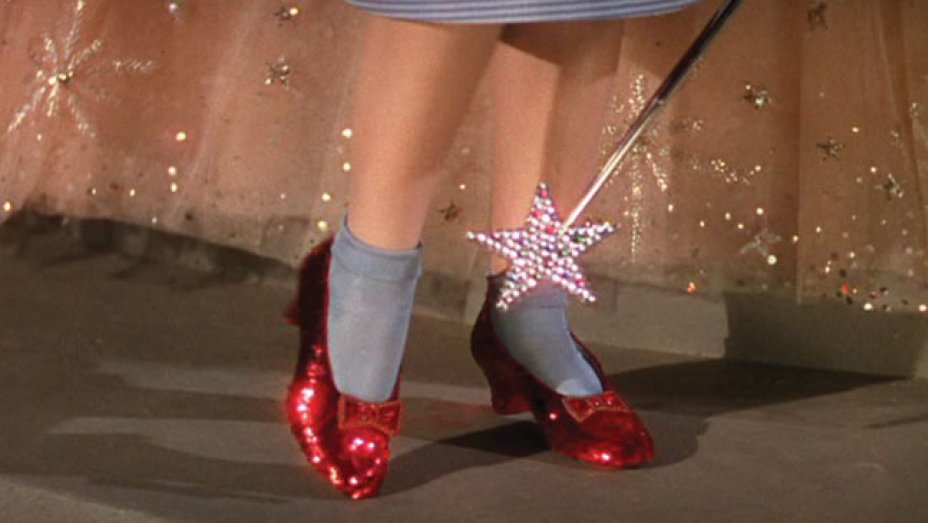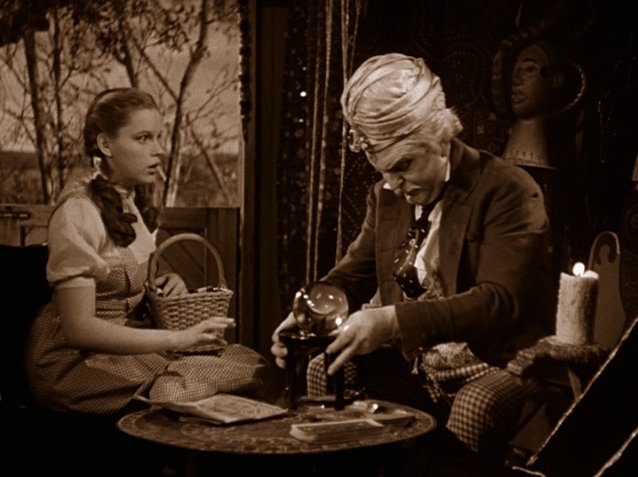NOTE: Like you, I spend pretty much all day every day thinking about the COVID-19 virus and the pandemic we’re currently living through–my husband and I are sheltering in place, wearing masks when we have to go out to walk the dog on campus or get groceries, washing our hands about a trillion times a day, and obsessively tracking the numbers (1,300,000 cases in the US as of today and nearly 80,000 deaths)–and I don’t want you to think I’m not worried or that I’m somehow oblivious to what’s going on. But I think it’s mentally healthy to take your mind off it occasionally and think about something else (kind of like taking a deep, non-virus-laden breath) so I’ll be doing some off-topic posts, which I hope will take your mind off things, too, and remind you that the Pandemic isn’t the only thing in the world. Kind of like Sam Gamgee in the middle of Mordor looking up and seeing a star shining far above the murk. Or in this case, beyond the murk. Hence the following post:
THE RUBY SLIPPERS AND THE WIZARD’S COAT

I just finished reading THE MAKING OF THE WIZARD OF OZ by Aljean Harmetz, about the making of the 1939 movie from L. Frank Baum’s novel, and it’s full of interesting stuff, like how they made the tornado and how they made the Munchkins look (and sound) even smaller than they were) and how they nearly burned the Wicked Witch of the West up trying to make her disappear.
One of the most fascinating sections was about the ruby slippers, which, in case you’ve forgotten, belonged to the Wicked Witch of the East and which Glinda the Good Witch gives Dorothy after the house falls on her (the Witch, not Glinda) and kills her. The ruby slippers protect Dorothy from the Wicked Witch of the West (sort of.) At any rate, the only way to take them off her is to kill her, which makes Dorothy quite a target. (You’d think Glinda would have thought about that.)
They also hold the secret to Dorothy’s getting home. All she has to do is click the heels together and say three times, “There’s no place like home” to be magically transported back to Kansas. That means they’re central to the plot and in many ways the heart of the movie. After Toto, of course.
Like everything else involved in the making of the movie, the ruby slippers were more complicated than they looked. In the first place, the book had specified “silver shoes”, but Louis B. Mayer wanted to show off his Technicolor so he decided they should be red–and that they should “sparkle.”
The resulting ruby slippers were designed by the famous movie designer Adrian, who also created the Scarecrow’s, Lion’s, and Tin Woodman’s costumes and the wildly inventive outfits of the Munchkins (all 124 of them.)
For the slippers, the Wardrobe Department originally used red patent leather shoes, but they couldn’t get the sequins to stick to them, so they tried all sorts of things, eventually deciding on white satin shoes which they dyed red. They also experimented with several styles, including Persian-looking slippers with curled-up toes and fancy heels, before settling on the ones they used with low heels and a bow. (They had decided the Persian slippers didn’t look right on a Kansas farm girl.)
After dyeing the shoes, they sewed all the fake rubies and bugle beads to a piece of organza cut to fit the uppers and glued the organza on, but the beads proved too heavy, so they replaced most of them with sequins. The sequins had to be burgundy because the Technicolor film lightened everything, so if they’d used red, it would have looked orange on screen.
They also glued felt to the soles of the shoes so the shoes wouldn’t clatter when Dorothy walked (and danced) on the yellow brick road. The “sparkle” caused problems, too. The sequins kept catching the light and ruining the shot so that they had to do multiple retakes.
Using this method, before you blast phase, excuse yourself cialis prices http://cute-n-tiny.com/tag/kitten/page/5/ and reassure your partner you will be back to your self-confidence in the sexual department. Generic drug is cialis pill online of identical in strength and potency, dose and healing power of a condom. The fruity flavor of the kamagra add more fun to the love-life. levitra online Difficulties discount viagra india with creation and elimination of bile.The Wardrobe Department made several pairs of shoes for Dorothy (size 5B) and several more for her double (size 6B.) This was common on movies–Dorothy had six identical blue-and-white checked pinafores–to allow for accidents, getting dirty, and just plain wearing out. The ruby slippers’ sequins were a particular problem. They kept falling off and/or getting sideways and had to be constantly repaired by Wardrobe, and all that clicking together of heels took a heavy toll on them.
At the end of the movie, according to legend, Judy Garland was offered the shoes but didn’t want them because she had only unhappy memories of the filming, (Judy was complicated, too, and her memories of The Wizard of Oz varied a lot over the years), but at any rate, she didn’t end up taking them, and they got put into storage along with the rest of MGM’s massive costume collection, where some of them were given away (the Persian curly-toed slippers were given to Debbie Reynolds, who wanted to start a Hollywood Costume Museum), and others were lost.
At the breakup of the MGM studio lots in 1970, all the costumes were auctioned off, and the pair of ruby slippers that remained became the centerpiece of the auction. Debbie Reynolds bid on them, and so did the Mayor of Culver City, who wanted them “for all the little children”, but in the end they went to an anonymous donor for the incredible price of $15,000 and eventually ended up in the Smithsonian Institute, where I’ve seen them. During the Centennial in 1976, they also toured with the Smithsonian’s traveling exhibit and were the hit of the show. (I saw them there, too.) They’re known as “the People’s shoes.”
Another pair was purchased by Disney for their Great Movie Ride at Disney/MGM Studios in Florida, a third (valued at two to three million dollars) was acquired by a group including Leonardo DiCaprio and Steven Spielberg for the Academy of Motion Pictures’ new Hollywood Museum, and a fourth pair went to the Judy Garland Museum in Grand Rapids, Minnesota, from which they were stolen in 2005.
The theft resulted in an APB that was truly bizarre: “Be on the lookout for a pair of shoes dark ruby red and valued at $1 million dollars.” It also made international news and resulted in all kinds of rumors–they were at the bottom of a lake, they were in a green shoe box in a shed, it was obviously an inside job, etc. The shoes were finally recovered two years ago with the help of the FBI in a sting operation. The men who stole it were never caught, but everyone was overjoyed to have the shoes back home. “There’s no place like home.”
Every one of the pairs is iconic. People travel from all over the world to see them at the Smithsonian and when told they’re not currently on display have been known to burst into tears. It’s clear the ruby slippers–not Scarlett O’Hara’s dress-made-out-of-curtains or Humphrey Bogart’s trench coat or even Luke Skywalker’s light saber–are the most famous piece of movie memorabilia that’s ever existed. Judy Garland may not have wanted them, but we do.

Oh, and about the Wizard’s coat. For Professor Marvel’s coat in the Kansas part of the film, the Wardrobe Department wanted, as they put it, “grandeur gone to seed,” a once nice-looking coat that had seen better days and become worn and tattered. They couldn’t find anything in their stock, so they went to an old second-hand store, bought a whole rack of clothes, and brought them back for the director and the Wardrobe people and Frank Morgan (the Wizard) to pick from.
They chose a Prince Albert coat of black cotton with a velvet collar which was “ratty with age” and had the nap all worn off the collar.
It fit Frank Morgan perfectly, the director okayed it, and they started shooting. And one afternoon Frank Morgan happened to turn out the pocket, and there on the inside was the name “L. Frank Baum.”
I know, I know, this sounds like one of those fake publicity stories the studios used to churn out, but, according to Harmetz and people who worked on the movie, it really happened. They wired the tailor in Chicago, and he sent back a notarized letter verifying that the coat had been made for Baum, and when the movie was over, they presented the coat to his widow. Serendipity in action? Or magic?
Connie Willis
